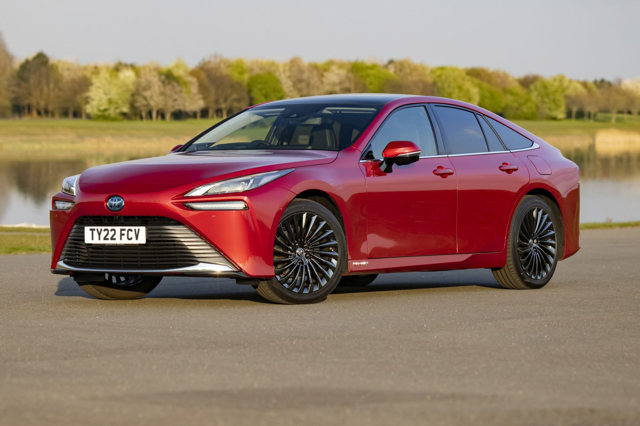Toyota Mirai Review 2025
Toyota Mirai At A Glance
With a 400-mile range and no emissions other than pure water, Toyota says the Mirai fuel-cell EV will cater for drivers needing to travel further than conventional electric cars.
Based on Toyota’s modular GA-L platform, with the fuel cell stack moved from beneath the cabin to the front compartment, the new Mirai has a more spacious, five-seat interior with improved legroom for rear seat passengers.
The new Mirai is equipped with lithium-ion high-voltage battery in place of the current model’s nickel-metal hydride unit. Although smaller in size, it is more energy-dense, giving higher output and superior environmental performance.
The battery’s smaller dimensions have allowed it to be positioned behind the rear seats, avoiding intrusion in the load compartment.
The adoption of the GA-L platform for the new Mirai gives the car fundamental benefits of a lower centre of gravity, improved inertia characteristics and significantly increased body rigidity, all of which help deliver superior dynamic performance.
With the fuel cell stack moved from beneath the vehicle floor to the front compartment and the battery and electric motor positioned at the rear, a 50:50 front:rear weight balance has been achieved, giving it the fundamental stability characteristics of a front-engine car.
The new platform also accommodates new multilink front and rear suspension, in place of the previous front MacPherson struts and rear torsion beam arrangement. This set-up provides a high level of stability, controllability and ride comfort. Details include the use of thicker anti-roll bars, optimal upper and lower ball joint location and overall high suspension rigidity, yielding rewards in terms of responsiveness and stability.
The Mirai's 19 and 20-inch wheels are fitted with 235/55 R19 and 245/45 R20 tyres respectively, with low rolling resistance and quiet running, contributing to fuel efficiency, handling quality, stability and a quiet cabin environment. Using larger diameter wheels and tyres helps secure the space required for the new triple hydrogen fuel tanks.
The car’s improved aerodynamics, with a lower roof line, full under cover and lower drag coefficient figure, plays its part too in raising the quality of handling and stability, and achieving the longer cruising range.
Toyota Mirai models and specs
| Dimensions | |
|---|---|
| Length | 4975 mm |
| Width | - |
| Height | 1480 mm |
| Wheelbase | 2920 mm |
| Miscellaneous | |
|---|---|
| Kerb Weight | 1950 kg |
| Boot Space | 321 L |
| Warranty | 3 years / 60000 miles |
| Servicing | 5000 miles |
| Costs | |
|---|---|
| List Price | £49,940 |
| Insurance Groups | - |
| Road Tax Bands | - |
| Official MPG | - |
| Euro NCAP Safety Ratings | |
|---|---|
| Adult | - |
| Child | - |
| Pedestrian | - |
| Overall | - |
| Saloon | |||
|---|---|---|---|
| Version | List Price | MPG | 0-62 |
| Design FCEV Auto 4dr | £49,940 | - | 9.0 s |
| Design Plus FCEV Auto 4dr | - | - | 9.0 s |
| Design Premium FCEV Auto 4dr | - | - | 9.0 s |
Model History
November 2020
Second-generation Toyota Mirai revealed
With a 400-mile range and no emissions other than pure water, Toyota says the Mirai fuel-cell EV will cater for drivers needing to travel further than conventional electric cars.
Based on Toyota’s modular GA-L platform, with the fuel cell stack moved from beneath the cabin to the front compartment, the new Mirai has a more spacious, five-seat interior with improved legroom for rear seat passengers.
The new Mirai is equipped with lithium-ion high-voltage battery in place of the current model’s nickel-metal hydride unit. Although smaller in size, it is more energy-dense, giving higher output and superior environmental performance.
The battery’s smaller dimensions have allowed it to be positioned behind the rear seats, avoiding intrusion in the load compartment.
The adoption of the GA-L platform for the new Mirai gives the car fundamental benefits of a lower centre of gravity, improved inertia characteristics and significantly increased body rigidity, all of which help deliver superior dynamic performance.
With the fuel cell stack moved from beneath the vehicle floor to the front compartment and the battery and electric motor positioned at the rear, a 50:50 front:rear weight balance has been achieved, giving it the fundamental stability characteristics of a front-engine car.
The new platform also accommodates new multilink front and rear suspension, in place of the previous front MacPherson struts and rear torsion beam arrangement. This set-up provides a high level of stability, controllability and ride comfort. Details include the use of thicker anti-roll bars, optimal upper and lower ball joint location and overall high suspension rigidity, yielding rewards in terms of responsiveness and stability.
The Mirai's 19 and 20-inch wheels are fitted with 235/55 R19 and 245/45 R20 tyres respectively, with low rolling resistance and quiet running, contributing to fuel efficiency, handling quality, stability and a quiet cabin environment. Using larger diameter wheels and tyres helps secure the space required for the new triple hydrogen fuel tanks.
The car’s improved aerodynamics, with a lower roof line, full under cover and lower drag coefficient figure, plays its part too in raising the quality of handling and stability, and achieving the longer cruising range.









 FCEV with 400-mile range.
FCEV with 400-mile range.
 Prices to be announced.
Prices to be announced.